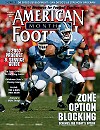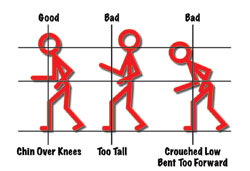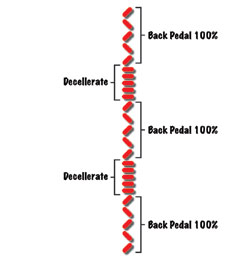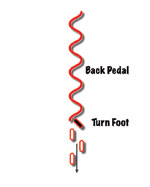AMERICAN FOOTBALL MONTHLY THE #1 RESOURCE FOR FOOTBALL COACHES
Article CategoriesAFM Magazine
|
The Speed ReportDeveloping Reaction Speed for Defensive Backs (Part II)by: Dale Baskett Football Speed Specialist © More from this issue Defensive back speed is often perceived by coaches as having an athlete with great 40 speed and ability to spring back well, change direction quickly, etc. Normally speaking, the better athletes are your DB’s. So if their 40 is awesome, the ability to leap and change direction is awesome to awesome plus. But then how do we improve DB speed? Simple – the movement spectrum required athletically is probably the most complex of any position on the field of play. Therefore, I am providing a series of drills that will succeed the 40, the leaps and the athletic naturals (i.e., genetics). The following represents a handful of drills I have avaliable for creating intricate movement additives to basic DB movements. The drills and techniques will enhance movement skills for any level. They will serve to help correct improper body control movements as well as add technical procedures that are not currently in place. I have spent 26 years honing my craft and exploring the scientific aspects of productive human movement essentials. Through research trial and error, I have developed many effective drills and movement formulas that can be applied. As far as research is concerned, many things must be eliminated as we boil down the ingredients to purify a finished product. I’m confident that the drills that follow will greatly enhance your DB’s speed and quickness capabilities. For the coaches who desire to develop their athletes more thoroughly for speed movement and quickness beyond what these short articles will allow, contact my e-mail for information on speed development packages available. For example, “team speed” development, “athletic body control” development, and “position specific” training series, are each designed for off-season and in-season use. Drill #1 - Back Pedal Techniques It’s important to not crouch down too low and not bend forward too far, (chin becomes extented beyond toes). This puts your athlete in a position that will retard limb speed.
• Slight bend forward @ waist. • Slight bend @ knees. • Shoulder / chin over knees. • 90 degrees angle with arms. • Elbows in - focus on shoulder rotation. Applications: • Push forward with the foot each cycle. • Lift knee each step quickly. • Rotate shoulder joint aggressively (front to back). Drill # 2 - Back Pedal Accelerations
• 100% back pedal, (5 yds). • Decel, (5 yds). • 100%, (5 yds). • Repeat until you’ve had 4 accels. Drill # 3 - Back Pedal to Angle Breaks
• Apply same back pedal techniques as before • (KEY) Turn outside foot prior to ground contact on last stride coming down. • (KEY) Don’t bend at waist while redirecting. • (KEY) Arm rotation never stops during break changes-arm rotation keeps leg cycle active. • Foot turns; however second step is the most forceful push, not the first step. Drill # 4 - Lateral Technique Lateral technique is the most underrated human movement skill available. It allows an athlete to be able to move rapidly yet still not give up hip and foot strike relationship which is KEY to changing directions. Every school I've visited over the years has not had one athlete that could lateral effectively. Displacing momentum while running laterally is even worse; it's a valuable asset for every athlete, DB’s especially.
Let me explain lateral movement: • Right foot over left or vice versa if moving left. • Elbows in close to sides. • Arms rotate short and actively (non stop). • Hips are up, not low. Drill # 5-Lateral to Angle Breaks
• (Downhill Angle)-Right step redirects momentum. To the new angle - Force always comes from the ground up through the established line – foot to head. • (45 degrees) Right foot force application to new direction. • (Upfield) Left foot plant from lateral direction to upfield angle. • (Breakback) Right foot plant to reverse angle-turn foot. • The other direction would be vice versa for foot plant. Note: While moving laterally, DB must maintain arm cycle rotation on each direction change. Drill # 6 - Back pedal to 180 Upfield • Same back pedal techniques described earlier. • (KEY) Turn left foot before foot strike placement (If turning to the right side and vice versa). • (KEY) Elbows in close and shoulder/arm rotation never stops.
Drill # 7 - Lateral Switches
• Lateral one direction, turn foot as instructed prior, switch hips facing opposite direction. • Always turn to the direction of momentum (i.e., going right, turn right). • Arms active, elbows in. • Knees lift each step on the switch procedure for successfully rotating around the center axis of line. • 5-6 switches with continuous rhythmical stride patterns. Drill # 8 - Lateral Reverse
• Same straight line lateral action as switch drill. • Lateral to the (right) - we will be reversing back away from the directional momentum. • (KEY) Turn the lead foot of the direction you’re moving. If moving left, it will be left foot, etc. • (KEY) Keep the foot turn under your hip on strike placement, eyes level, non-stop arms, elbows in. • Arm tracking alignment slightly inward during rotation (this allows arm action to be in alignment with lead leg turn). |
|
| HOME |
MAGAZINE |
SUBSCRIBE | ONLINE COLUMNISTS | COACHING VIDEOS |
Copyright 2024, AmericanFootballMonthly.com
All Rights Reserved












